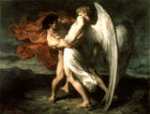If you haven’t done so yet, I would suggest that you stop and read these verses in your own Bible.
6: 27 Food which perishes: While earthly food is necessary to sustain our life on earth; we need something more to give us supernatural life or to guard us against death. (6: 49) Only Christ can give us food that satisfies our spiritual hunger and leads us to everlasting life. Eventually in 6: 50-58, this food will be identified as the Body and Blood of Christ in the Eucharist.
6: 31 He gave them bread: This is a reference to Exodus 14: 4. The manna that was provided by Moses was a food that was perishable. Even though it had a heavenly origin, it melted away every morning and turned rotten if stored over night.
6: 32 the true bread: The manna was merely a sign of the imperishable bread that the Father sends down from heaven in His Son, Jesus.
The Bread of Life Discourse: Invitation to Faith (6: 35-47)
“I am the Bread of Life.” This is followed by a string of invitations to come to Jesus and believe in Him for salvation. The import of this metaphorical teaching of Jesus is not lost on the Jews, because they don’t ask Him why He calls Himself bread, but how can He claim to have come down from Heaven. (6: 41 “Jews then murmured.”–just like they did in the desert about the manna.)
The Bread of Life Discourse: Invitation to the Eucharist (6: 48-58)
“I am the Bread of Life.” We are invited to eat the flesh of Jesus and drink His blood. The impact of this literal teaching of Jesus is not lost on the Jews either, because they ask how is it possible for them to eat His flesh. (6: 32) The crowd is thinking of cannibalism, which would be repugnant to them. They misunderstand because Jesus give us His glorified humanity that was His after the resurrection. This is why He calls Himself “the living bread.” (6: 51)
We conclude then that without faith we cannot be united to Christ or recognize Him in the Eucharist. If eating is believing in 6: 35-47; then believing leads to eating in 6: 48-58.
The Words of Eternal Life
6: 66 His disciples drew back. This is the only time in the Gospels when Jesus is abandoned by His disciples in such large numbers. Yet, Jesus does not soften His words or make any effort to clear up any possible misunderstanding. Instead He asks “Will you also go away?” (6: 67)
6: 68-70 Peter’s profession of faith: He speaks from his heart because he doesn’t yet understand the mysteries that Jesus has just revealed. “Lord, to whom shall we go? You have the words of eternal life; and we have believed, and have come to know, that you are the Holy One of God.”

The Promises of Eucharistic Adoration
Next time: Early Christian Worship and the Liturgical Calendar.
Meditation: Reread John 6: 68-70. What new insight about my faith have I received from this scripture?




